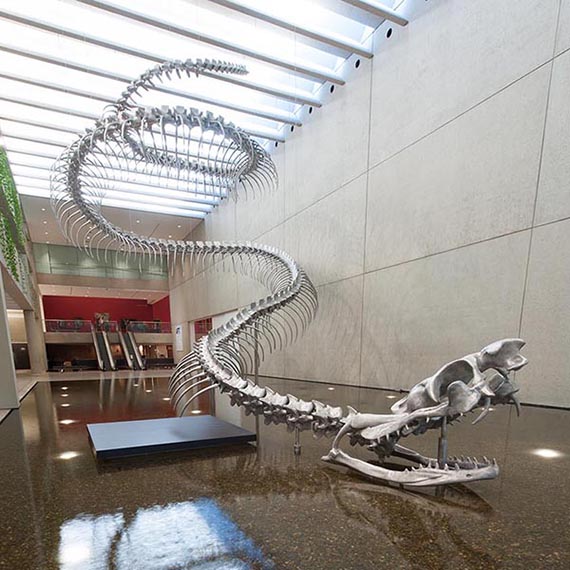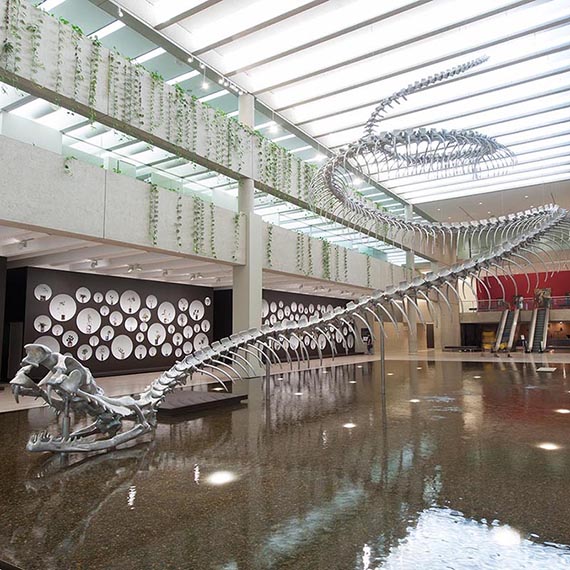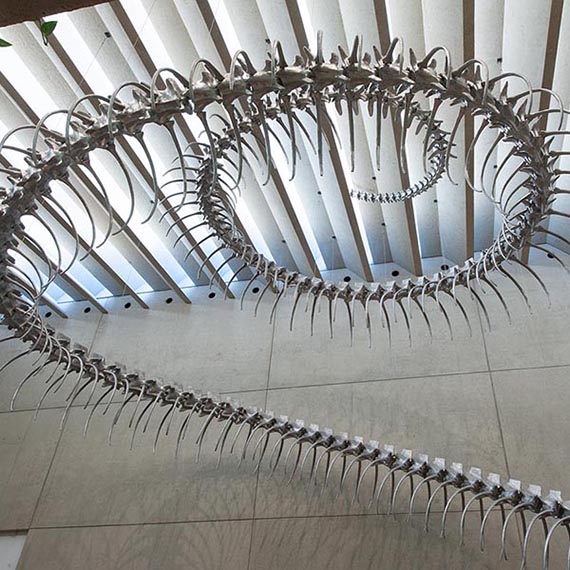
The Gallery commissioned and acquired one of the signature works of The 7th Asia Pacific Triennial of Contemporary Art (APT7), Ressort 2012, a sculpture by the Chinese–French artist Huang Yong Ping.
The gigantic aluminium snake skeleton that spirals 53 metres across the Watermall, Ressort 2012 was a fitting centrepiece for APT7. This is not only because it is a major work by one of the leading figures in Chinese contemporary art, but also because it embodies many of the ideas that drive the APT and the Gallery, with its emphasis on cross-cultural dialogue, its engagement with audiences, and its thoughtful response to site and context.



Huang was born in Xiamen in southern China in 1954. Along with artists such as Zhang Xiaogang and Xu Bing, he was part of the first wave of students admitted to the newly reopened art academies following the Cultural Revolution (1966–76). While at the Zhejiang Academy of Fine Arts in the late 1970s and early 1980s, Huang gained access to Western art and philosophy books in Chinese translation, and became interested in French postmodern theory and the work of Marcel Duchamp, John Cage and Joseph Beuys. Huang found connections between Taoist and Zen Buddhist thought, with its embrace of constant change, and the deconstructive, dematerialising strategies of Dada. In 1986, he co-founded the influential avant-garde group Xiamen Dada, which staged several radical events that included burning paintings at the end of an exhibition, and installing construction materials in a gallery instead of art works.
Since 1989, Huang has lived in Paris. As with many artists of his generation, he left China at the time of the Tiananmen Square crackdown, which registered an end to the increasingly open expression that had built since the end of the Cultural Revolution. Living in France enabled Huang to participate actively in the international art world, exhibiting widely and raising awareness of Chinese avant-garde art, particularly in Europe. It also encouraged him to shift his practice to address the interaction of different cultures in an increasingly globalised world. In Huang’s works since 1989, Chinese symbols and mythology are often intertwined with those of the West, overlaid with references to the locality where the work is shown.
This approach is clearly evident in Ressort, which was commissioned for APT7 and the Collection. Here Huang expands the form of the snake, a regular motif in his work, to a gigantic scale. ‘Ressort’ is French for ‘spring’, and can also mean energy or resilience, and the snake skeleton coils from the roof to the floor, as if coming down from the sky, with its skull floating just above the water. The coiled snake or dragon, a central figure in Chinese mythology since ancient times, is traditionally associated with water; the snake also represents knowledge and wisdom. The snake/dragon is also a key figure in other cultures, appearing in the Garden of Eden in the Bible, as the Naga in Southeast Asia, as the foe to Beowulf or Saint George in Anglo–Saxon mythology, and as the Rainbow Serpent in Australian Aboriginal culture. It is alternatively a symbol of fear, creation, desire, deception or good luck.
Ressort suggests movement through its sinuous loops, but the skeleton is static, like a dinosaur fossil in a museum. It is gigantic, larger than any snake could be, but scale is relative, according to Huang: what is huge in one context is tiny in another. The fluidity and ambiguity of the snake powerfully express the tensions that Huang Yong Ping likes to keep in play in his work. Nothing is certain, meaning is created through the interdependence of things rather than via fixed truths, and we are all subject to the forces of chance and change.
Russell Storer is former Curatorial Manager, Asian and Pacific Art, QAGOMA
Watch | The installation
Watch | Huang Yong Ping
#QAGOMA


As I looked at this work I thought of the dragon first not the snake because of the size of the work. I was interested to read that Huang liked Dada ideas as I’m also intrigued with them. They continue to influence and inform my work. I found the APT7 an ongoing source of inspiration for which I thank the directors of the QAG and GOMA.